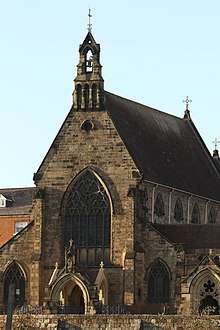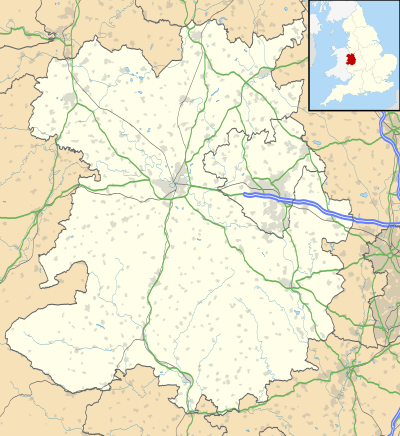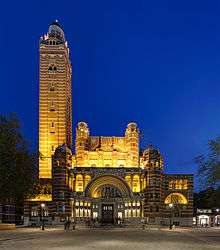Shrewsbury Cathedral
The Cathedral Church of Our Lady Help of Christians and Saint Peter of Alcantara, commonly known as Shrewsbury Cathedral, is a Roman Catholic cathedral in Shrewsbury, England. It is the seat of the Roman Catholic Bishop of Shrewsbury and mother church of the Diocese of Shrewsbury which covers the historic counties of Shropshire and Cheshire.
| Shrewsbury Cathedral | |
|---|---|
| Cathedral Church of Our Lady Help of Christians and Saint Peter of Alcantara | |
 | |
 Shrewsbury Cathedral Shown within Shropshire | |
| Location | Shrewsbury, Shropshire |
| Country | England |
| Denomination | Roman Catholic |
| Website | shrewsburycathedral.org |
| History | |
| Status | Cathedral |
| Consecrated | 1856 |
| Architecture | |
| Heritage designation | Grade II*[1] |
| Designated | 1953 |
| Architect(s) | E. W. Pugin |
| Style | Gothic Revival |
| Groundbreaking | 1852 |
| Completed | 1856 |
| Administration | |
| Diocese | Shrewsbury (since 1856) |
| Province | Birmingham |
| Clergy | |
| Bishop(s) | Rt Rev. Mark Davies |
| Laity | |
| Director of music | Jon Barton |
| Organist(s) | Jon Barton |
History
Construction
The building of the cathedral was originally commissioned by John Talbot, 16th Earl of Shrewsbury, the intended architect being Augustus Welby Northmore Pugin but both men died in 1852 before the work was expected to start. The succeeding nephew, the 17th Earl, Bertram Talbot offered to fund the building of the cathedral [2] from which the new diocese of Shrewsbury would be based. The cathedral's design was taken over by Edward Pugin (the son of Augustus).[2] Originally, a larger cathedral with a tall spire was planned. However, two years into the building of the cathedral, a stratum of sand was discovered very close to the building's foundations, causing them to be weaker than expected, so the spire had to be abandoned and the building scaled down.[3] The Earl of Shrewsbury then agreed to meet the cost of a smaller church, and this was finished at a cost of £4,000, although the Earl died three months prior to its completion. In 1856, the cathedral was completed and was opened by Cardinal Wiseman.[4]
On 30 October 1956, a Mass was said in the cathedral to commemorate its centenary. The Mass was celebrated by Archbishop Francis Grimshaw of Birmingham, Bishop John Murphy of Shrewsbury, Bishop Cyril Restieaux of Plymouth. Bishop Edward Ellis of Nottingham, Bishop John Rudderham of Clifton and Bishop John Petit of Menevia.[3]
Re-ordered
In 1984, the cathedral was re-ordered which brought it in line with the revised liturgy of the Second Vatican Council. Local Grinshill stone was used for the new altar which was consecrated in 1985 by Bishop Joseph Gray.
In 2019, it was decided by bishop Mark Davies that the interior of the cathedral will be restored to its original state. [5]
The seating has a capacity of 300.[2]
Windows
The cathedral has several stained glass windows. The older set of windows are mostly from the stained glass company Hardman & Co. from Birmingham. The cathedral also has seven windows made during the second and third decades of the twentieth century by an artist inspired by the Arts and Crafts movement, Margaret Agnes Rope. She was the daughter of a local doctor and had a studio in the Glass House in Fulham.[6] Later, she became a Carmelite nun, following training in Dublin. Her cousin M. E. Aldrich Rope designed windows for St Peter and St Paul Church in Bromley among many other churches.[7]
War Memorial
Margaret Agnes Rope also designed the cathedral's war memorial, in the west porch, to the 63 men of its congregation who died serving in World War I. It consists of a pieta with a wooden plaque below displaying the regimental badge of the King's Shropshire Light Infantry (the main county regiment), and the arms of Shropshire and Shrewsbury. The list of names is below and at its foot is inscribed the opening line in Latin of the Requiem Mass. Nearby was placed a plaque to mark the 50th anniversary of the end of World War II in 1995.[8]
Location
The cathedral is on a street called Town Walls, adjacent to the historic town wall, within the main meander of the River Severn in the centre of Shrewsbury. It is surrounded by a mainly residential neighbourhood.
Gallery
- North side of the cathedral
 St Cecilia window
St Cecilia window West window
West window
References
- Historic England, "Roman Catholic Cathedral of Our Lady Help of Christians and St Peter (1270562)", National Heritage List for England, retrieved 15 December 2013
- "The small cathedral with a massive heart. Stained glass and tranquil atmosphere charm thousands of visitors". Shropshire Star. 8 August 2015. p. 14.Church Spotlight report.
- 26 October 1956 from Catholic Herald Archive accessed 6 April 2013
- History of the Cathedral, Diocese of Shrewsbury
- https://catholicherald.co.uk/magazine/why-im-restoring-my-pugin-cathedral-to-its-former-glory/
- Glass House Fulham from Art Biographies accessed 6 April 2013
- Two Margaret Ropes accessed 6 April 2013
- Francis, Peter (2013). Shropshire War Memorials, Sites of Remembrance. YouCaxton Publications. pp. 192–193. ISBN 978-1-909644-11-3.
External links
- Shrewsbury Cathedral Official Website
- Diocese of Shrewsbury Official Website
- The Catholic Church in England and Wales
